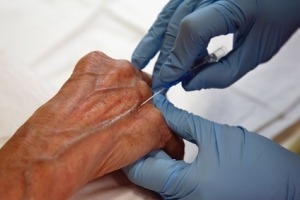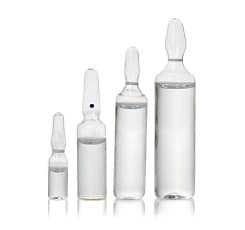Prospective evaluation of a dynamic insulin infusion algorithm

This study primarily aimed to evaluate the efficacy of a dynamic algorithm of intravenous insulin therapy in non-critically-ill patients, and addressed its safety and feasibility in different departments of our university hospital” Montanier et al (2019). Abstract: INTRODUCTION: Insulin infusion is recommended during management of diabetic patients in critical care units to rapidly achieve glycaemic […]
Mechanism of extravasation via umbilical venous catheters

A rare complication of umbilical venous catheter (UVC) insertion is the extravasation of the infusate into the peritoneal cavity” Hargitai et al (2019). Abstract: A rare complication of umbilical venous catheter (UVC) insertion is the extravasation of the infusate into the peritoneal cavity. We report 3 cases of abdominal extravasation of parenteral nutrition (PN) fluid […]
Web-based solution for bidirectional EHR-infusion pump communication

Smart Agent is a web-based solution for establishing bidirectional communication between an infusion pump and an electronic health record (EHR). It eliminates the need for clinician double check of medication administration using an infusion pump” Griffiths et al (2019). Abstract: Smart Agent is a web-based solution for establishing bidirectional communication between an infusion pump and […]
Reducing pain and fear associated with phlebotomy

This study aimed to investigate the effects of the Buzzy, Jet lidokaine, bubble-blowing and inhalation aromatherapy with lavender essence on pain, stress and fear in children undergoing phlebotomy” Alemdar and Aktaş (2019). Abstract: Purpose: This study aimed to investigate the effects of the Buzzy, Jet lidokaine, bubble-blowing and inhalation aromatherapy with lavender essence on pain, […]
Catheter-related bloodstream infections with coagulase-negative staphylococci

The main objective of this study was to elucidate the role of systemic antibiotic therapy in the setting of catheter removal in adult patients with CoNS-CRBSI” Hebeisen et al (2019). Abstract: Background: Catheter-related bloodstream infections (CRBSI) with coagulase-negative Staphylococci (CoNS) are a common source of hospital-acquired bloodstream infections. The main objective of this study was […]
Intravenous compared with oral iron for the treatment of iron-deficiency anemia in pregnancy

To assess the effect of intravenous versus oral iron on hematologic indices and clinical outcomes for iron-deficiency anemia (IDA) in pregnancy” Lewkowitz et al (2019). Abstract: Objective: To assess the effect of intravenous versus oral iron on hematologic indices and clinical outcomes for iron-deficiency anemia (IDA) in pregnancy. Study design: Searches in Ovid Medline, Embase, […]
Patients knowledge and experience with peripheral intravenous catheters

The aim of this study is to investigate patients knowledge and experience with catheters, to design patient interventions to reduce inappropriate catheter use” Laan et al (2019). Abstract: PURPOSE: Inappropriate use of urinary and intravenous catheters is still frequent. The use of catheters is associated with some serious complications, such as health care associated infections […]
Vascular access infection by Staphylococcus aureus

Hemodialysis patients are particularly vulnerable to Staphylococcus aureus infection, with the vascular access serving as the site of entry for this formidable pathogen” Chu et al (2019). Abstract: Hemodialysis patients are particularly vulnerable to Staphylococcus aureus infection, with the vascular access serving as the site of entry for this formidable pathogen. Patients with arteriovenous grafts […]
Vascular access for hemodialysis in the elderly

The objective of this study was to compare the outcomes of arteriovenous fistulas (AVFs) with arteriovenous grafts (AVGs) in a large population-based cohort of elderly patients in the United States” Arhuidese et al (2019). Abstract: OBJECTIVE: The objective of this study was to compare the outcomes of arteriovenous fistulas (AVFs) with arteriovenous grafts (AVGs) in […]
Insulin balanced infusion system closed-loop system

Optimal glucose control has been shown to be useful in critical care as well as in other settings. Glucose concentrations in patients admitted to critical care are characterized by marked variability and hypoglycemia due to inadequate sensing and treatment technologies” Hashemi et al (2019). Abstract: BACKGROUND: Optimal glucose control has been shown to be useful […]
Insulin pumps and continuous glucose monitors

We sought to assess fellows’ knowledge, attitudes, and practices regarding insulin pumps and CGMs using a mixed-methods survey” Marks et al (2019). Abstract: BACKGROUND: Recent data demonstrating a lack of improvement in average hemoglobin A1c levels despite the increased use of insulin pumps and continuous glucose monitors (CGMs) suggest that patients are not using these […]
Patient-reported complications related to PICC

The objective of this study was to systematically elicit and characterise PICC-related complications as experienced by patients during and after hospitalisation” Krein et al (2019). Abstract: OBJECTIVE: Peripherally inserted central catheters (PICC) are frequently used to deliver medical therapies, but our knowledge regarding PICC-related complications remains incomplete. The objective of this study was to systematically […]
Outcomes of patients with a history of injecting drug use and receipt of OPAT

Our aim is to publish our outcomes in this setting, to inform other clinicians’ decisions regarding PWID in OPAT” O’Callaghan et al (2019). Abstract: People who inject drugs (PWID) are susceptible to endovascular and deep-seated infections which require prolonged antibiotic therapy. There are concerns regarding this cohort’s suitability for outpatient parenteral antimicrobial therapy (OPAT), but […]
Outpatient infusion center with intravenous magnesium therapy

Exploratory study to investigate the effectiveness of intravenous magnesium as an abortive for status migrainosus in an outpatient infusion center, and characterize the patients who benefit from the therapy” Xu et al (2019). Abstract: OBJECTIVES: Exploratory study to investigate the effectiveness of intravenous magnesium as an abortive for status migrainosus in an outpatient infusion center, […]
Accuracy of two different approaches in locating the tip of the central venous catheter

The aim of this study was to compare the accuracy of two different approaches in locating the tip of the Central venous catheter (CVC) at the suggested vascular zone” Jarineshin et al (2019). Abstract: Introduction: The present guidelines recommend placing the catheter tip in the superior vena cava (SVC) above the pericardial cephalic reflection. The […]
Empowering patients to prevent CLABSI

The aim of the EPIC2 project was to reduce CLABSI rates on a hematology-oncology specialty unit with historically high CLABSI rates despite prior quality improvement efforts” Suttle et al (2019). Abstract: BACKGROUND: Central line-associated bloodstream infections (CLABSIs) are associated with an increased risk of mortality, prolonged hospitalizations, and inflated cost of care. Patients in the […]
Clinically-indicated replacement versus routine replacement of peripheral venous catheters

“There is moderate-certainty evidence of no clear difference in rates of CRBSI, thrombophlebitis, all-cause BSI, mortality and pain between clinically indicated or routine replacement of PIVC” Webster et al (2019).
Impact of clinical practice on vessel health in vascular access

Vascular access devices are commonly inserted devices that facilitate the administration of fluids and drugs, as well as blood sampling. Despite their common use in clinical settings, these devices are prone to occlusion and failure, requiring replacement and exposing the patient to ongoing discomfort/pain, local vessel inflammation and risk of infection” Hawthorn et al (2019). […]
Efficacy of vein visualisation devices for neonatal vascular access

The aim of this randomized controlled trial was to examine the efficacy of vein visualization devices and the routine method for insertion of peripheral intravenous catheters (PIVCs) in preterm infants” Çağlar et al (2019). Abstract: The aim of this randomized controlled trial was to examine the efficacy of vein visualization devices and the routine method […]
Risk factors for vascular catheter-related bloodstream infections

To determine the risk factors for acquiring central line-associated blood stream infections (CLABSI) in pediatric intensive care units” Torre et al (2018). Abstract: OBJECTIVES: To determine the risk factors for acquiring central line-associated blood stream infections (CLABSI) in pediatric intensive care units and to investigate the incidence and etiology of CLABSI in pediatric intensive care […]
Bloodstream infection in pediatric patients with intestinal failure and central venous catheters

We conducted a retrospective cohort study of febrile patients younger than 18 years with diagnosis of intestinal failure requiring a central venous catheter for home parenteral nutrition to identify factors associated with normal blood cultures to identify a low-risk subset” Fischer et al (2019). Abstract: OBJECTIVES: This study aimed to describe demographic, clinical, and laboratory […]
Accuracy and safety of intracavitary ECG guidance for neonatal PICC placement

The purpose of this study is to investigate the accuracy and safety of intracavitary electrocardiogram (IC-ECG) guidance for the localization of peripherally inserted central catheter (PICC) in neonatal patients” Ling et al (2019). Abstract: The purpose of this study is to investigate the accuracy and safety of intracavitary electrocardiogram (IC-ECG) guidance for the localization of […]
Point prevalence survey of peripheral venous catheter usage

The objectives of this survey were to estimate the prevalence of PVC and PVC-associated infections on peripheral wards of a large tertiary care hospital in Germany. The collected data may be utilized for a tailored infection prevention intervention in the future” Aghdassi et al (2019). Abstract: BACKGROUND: Bloodstream infections (BSI) are among the most frequently […]
Treatment of PICC-related thrombosis reviewed

We performed a retrospective analysis of hospitalized adult patients diagnosed with CRT at our center. We determined rates of progressive thrombosis and bleeding in cohorts of patients who underwent catheter removal vs those who had catheters removed and received anticoagulation” Shatzel et al (2019). Abstract: Peripherally-inserted central catheters (PICCs) are commonly used during hospitalization. Unfortunately, […]
National evaluation of safety peripheral intravenous catheters

This article presents an excerpt of a national evaluation undertaken by an independent team of NHS senior clinicians from different fields, commissioned by the Department of Health and Social Care into everyday healthcare consumables” Guerrero (2019). Abstract: Studies have demonstrated that up to 90% of all inpatients require the insertion of some form of an […]
Stability of cefuroxime for administration by continuous infusion

This study aims to determine the stability of a 90 mg/mL cefuroxime sodium solution. Cefuroxime sodium was reconstituted and mixed with 50-mL 0.9% saline to produce 90 mg/mL solution in polypropylene syringes which were stored at 4 °C, 25 °C and 40 °C” Vercheval et al (2018). Abstract: Continuous infusions of β-lactam antibiotics increase pharmacokinetic/pharmacodynamic target attainment. However, this way […]
Experience of a subcutaneously anchored sutureless system for securing central venous catheters

This article reports the results of three prospective clinical studies conducted in a university hospital regarding the efficacy, safety and cost effectiveness of a subcutaneously anchored sutureless system for securing central venous catheters” Pittiruti et al (2019). Abstract: This article reports the results of three prospective clinical studies conducted in a university hospital regarding the […]
Implementing an e-learning education program for syringe pump use

The aim of the present study was to challenge the implementation of an e-learning education program for syringe pump use” Saint-Marc metal (2019). Abstract: To prevent the incidence of risks imputable to human error during the process of preparing the infusion pump, clarity in teaching and learning are required. Because traditional classroom training is difficult […]
Sodium bicarbonate catheter lock solution reduces hemodialysis catheter loss

The objective of this study was to determine the safety and efficacy of using sodium bicarbonate catheter lock solution (SBCLS) as a means of preventing HD catheter loss due to CRT and CRBSI” El-Hennawy et al (2019). Abstract: BACKGROUND: There is no ideal lock solution that prevents hemodialysis (HD) catheter loss due to catheter-related thrombosis […]
Paediatric nurses’ adoption of aseptic non-touch technique

To provide insight into the challenges faced by clinical staff adopting ANTT during intravenous therapy” Isaac et al (2019). Abstract: BACKGROUND: In 2015, NHS Wales introduced a national standardised approach to aseptic non-touch technique (ANTT). This approach aims to standardise practice and promote better clinical outcomes. AIM: To provide insight into the challenges faced by […]

